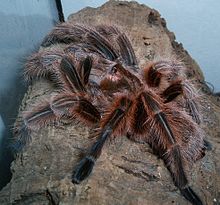Finding a Rose Hair Tarantula for sale involves exploring various avenues, including online retailers, local pet stores, reptile expos, and specialty breeders.
The Rose Hair Tarantula, scientifically known as Grammostola rosea, is one of the most popular pet tarantulas due to its docile nature and relatively easy care requirements.
This guide will provide a comprehensive overview of where to find these fascinating arachnids, along with tips on purchasing and caring for them.
1. Online Retailers
The internet is a primary source for purchasing Rose Hair Tarantulas. Numerous online retailers specialize in exotic pets, including tarantulas. Here are some reputable options:
Backwater Reptiles:
Known for a wide selection of reptiles and arachnids, Backwater Reptiles often has Rose Hair Tarantulas available at competitive prices. They provide detailed care information and a live arrival guarantee.
My Spider Shop:
This site offers various sizes of Chilean Rose Tarantulas, including slings, sub-adults, and adults. They are known for their customer service and quality animals.
Fear Not Tarantulas:
Specializing in tarantulas, this retailer provides a variety of species, including the Rose Hair Tarantula. They focus on the health and well-being of their animals.
Reptilian Arts:
This site features a selection of tarantulas, including the Rose Hair. They also offer care guides and other resources for new owners.
Urban Tarantulas:
A great source for various tarantula species, Urban Tarantulas often has the Rose Hair available and provides detailed care instructions.
2. Local Pet Stores
Many local pet stores carry Rose Hair Tarantulas due to their popularity among beginner and experienced keepers alike. When visiting a pet store, consider the following:
Check Availability:
Call ahead to see if they have Rose Hair Tarantulas in stock. Some stores may not always have them available.
Inspect the Animals:
When you visit, take the time to inspect the tarantulas for signs of health issues, such as lethargy or abnormal behavior.
Ask Questions:
Don’t hesitate to ask the staff about the care requirements and history of the tarantulas they have for sale.
3. Reptile Expos and Shows
Reptile expos and shows are excellent places to find Rose Hair Tarantulas. These events typically feature multiple vendors, allowing you to compare prices and conditions. Here’s what to keep in mind:
Networking Opportunities:
You can meet breeders and other enthusiasts, which can provide valuable insights into care and husbandry.
Variety of Options: Vendors often have a range of sizes and color morphs, giving you more choices than you might find in a pet store.
In-Person Inspection: You can inspect the tarantulas in person, ensuring you choose a healthy specimen.
4. Specialty Breeders
Finding a reputable breeder can be one of the best ways to acquire a Rose Hair Tarantula. Breeders often have a deeper knowledge of the species and can provide specific care information. Here’s how to find them:
Research Local Breeders:
Look for breeders in your area or those who ship. Websites and social media platforms can help you connect with them.
Ask for References: A good breeder should be able to provide references or testimonials from previous customers.
Inquire About Care: Breeders can offer detailed information about the tarantula’s care, including feeding schedules and habitat requirements.
5. Online Marketplaces
Websites like eBay and Craigslist may have listings for Rose Hair Tarantulas. However, exercise caution when using these platforms:
Verify Seller Reputation:
Check the seller’s ratings and reviews to ensure they are reputable.
Health Checks: Always ask for information about the tarantula’s health and care history.
Local Pickup: If possible, arrange for a local pickup to inspect the tarantula before purchasing.
6. Social Media Groups
Joining tarantula enthusiast groups on platforms like Facebook can connect you with individuals selling or trading Rose Hair Tarantulas. These groups often provide a wealth of information and support for new keepers. Here’s how to make the most of them:
Engage with the Community:
Ask questions and share your experiences. The community can provide valuable insights and recommendations.
Look for Sales: Members often post about available tarantulas for sale or trade, which can lead to finding a Rose Hair.
Learn from Others: Experienced keepers can offer tips on care, feeding, and habitat setup.
Considerations When Buying
When purchasing a Rose Hair Tarantula, consider the following factors to ensure you make a responsible choice:
Health and Condition:
Always check the health of the tarantula before purchasing. Look for signs of molting or any physical abnormalities.
Shipping Policies: If buying online, review the seller’s shipping policies to ensure the tarantula will be transported safely and humanely.
Care Requirements: Familiarize yourself with the care requirements for Rose Hair Tarantulas, including habitat setup, diet, and temperature needs, to ensure you can provide a suitable environment.
Conclusion
Finding a Rose Hair Tarantula for sale can be an exciting journey. By exploring various options, including online retailers, local pet stores, reptile expos, specialty breeders, online marketplaces, and social media groups, you can find a healthy and well-cared-for tarantula. Always prioritize the health and well-being of the animal, and ensure you are prepared to meet its care needs. With the right preparation and knowledge, you can enjoy the rewarding experience of keeping a Rose Hair Tarantula as a pet. ### Additional Resources for Rose Hair Tarantula Care
Once you have acquired your Rose Hair Tarantula, it’s essential to understand how to care for it properly. Here are some resources and tips to help you provide the best environment for your new pet.
1. Care Guides and Books
Books:
Look for books specifically about tarantula care. Titles like “The Tarantula Keeper’s Guide” by Stan Shultz provide in-depth information on care, feeding, and habitat setup.
Online Articles: Websites dedicated to exotic pet care often have comprehensive articles on tarantula husbandry. These can be a great source of information for both beginners and experienced keepers.
2. Online Forums and Communities
Tarantula Forums: Websites like Arachnoboards and Tarantula Forum are excellent places to ask questions, share experiences, and learn from other tarantula enthusiasts.
YouTube Channels:
Many keepers share their experiences and care tips through video content. Channels dedicated to tarantulas can provide visual guidance on habitat setup and feeding.
3. Local Tarantula Clubs
Join a Club: Many areas have local tarantula or reptile clubs where enthusiasts gather to share knowledge and experiences. Joining a club can provide networking opportunities and access to local breeders.
Workshops and Events:
Clubs often host workshops or events that can enhance your understanding of tarantula care and husbandry.
Setting Up the Habitat
Creating a suitable habitat for your Rose Hair Tarantula is crucial for its health and well-being. Here are some key components to consider:
1. Enclosure
Size: A 10 to 20-gallon tank is typically sufficient for an adult Rose Hair Tarantula. Ensure the enclosure has a secure lid to prevent escapes.
Material: Glass or plastic terrariums are commonly used. Ensure the enclosure is well-ventilated.
2. Substrate
Type: Use a substrate that retains moisture but also allows for burrowing. Coconut fiber, peat moss, or a mixture of both works well.
Depth: Aim for a substrate depth of 2 to 4 inches to allow for burrowing behavior.
3. Temperature and Humidity
Temperature: Maintain a temperature range of 75°F to 85°F (24°C to 29°C). Use a heat mat or lamp if necessary, but avoid direct heat.
Humidity: Keep humidity levels around 40% to 60%. Mist the enclosure lightly to maintain moisture, but avoid over-saturation.
4. Hiding Spots
Decor: Provide hiding spots using items like cork bark, caves, or commercially available tarantula hides. This helps reduce stress and provides a secure environment.
5. Water Source
Water Dish: Include a shallow water dish for hydration. Change the water regularly to prevent stagnation.
Feeding Your Rose Hair Tarantula
Feeding your Rose Hair Tarantula is an essential part of its care. Here are some guidelines:
1. Diet
Food Options:
Rose Hair Tarantulas primarily eat insects such as crickets, mealworms, and roaches. Occasionally, they can be fed small pinky mice, but this should be done sparingly.
Feeding Frequency: Juveniles may need to be fed every few days, while adults can be fed once a week or every other week.
2. Portion Size
Size of Prey: Ensure the prey is no larger than the width of the tarantula’s body to prevent choking.
Observation: Monitor your tarantula’s feeding habits. If it refuses food, it may be in pre-molt or experiencing stress.
Handling Your Rose Hair Tarantula
While Rose Hair Tarantulas are known for their docile nature, handling should be approached with caution:
1. When to Handle
Acclimation:
Allow your tarantula to acclimate to its new environment for a few weeks before attempting to handle it.
Short Sessions: If you choose to handle your tarantula, keep sessions short and gentle to minimize stress.
2. Techniques
Use a Container:
Instead of handling directly, consider using a container to move your tarantula. This reduces the risk of dropping or injuring it.
Avoid Sudden Movements: Move slowly and avoid sudden movements to prevent startling your tarantula.
Health Monitoring
Regularly monitoring your Rose Hair Tarantula’s health is vital for early detection of any issues:
1. Signs of Health
Active Behavior:
A healthy tarantula is usually active and responsive.
Eating Well: Regular feeding and a healthy appetite are good indicators of health.





